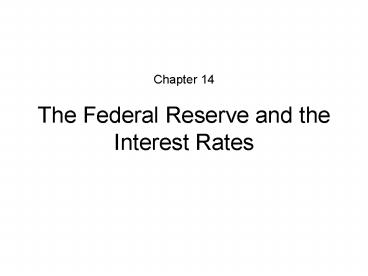Chapter 14 The Federal Reserve and the Interest Rates - PowerPoint PPT Presentation
1 / 11
Title:
Chapter 14 The Federal Reserve and the Interest Rates
Description:
The higher the fed funds rate, the more costly it is for banks to borrow and ... If the Fed does nothing, the federal funds rate increases. ... – PowerPoint PPT presentation
Number of Views:58
Avg rating:3.0/5.0
Title: Chapter 14 The Federal Reserve and the Interest Rates
1
Chapter 14The Federal Reserve and the Interest
Rates
2
The Federal Funds Market
- The federal funds market Where banks lend
reserves overnight - The federal funds rate is the nominal interest
rate on overnight loans between commercial banks. - The Fed's FOMC sets a target for the federal
funds rate, however, the federal funds rate is
determined by the supply and demand for federal
funds, or reserves.
3
The Feds Target
- The actual federal funds rate follows closely the
Feds target funds rate.
4
The Demand for Reserves
- Like all demand curves the demand for reserves is
downward sloping. - The higher the fed funds rate, the more costly it
is for banks to borrow and banks will borrow less.
5
Shifts in the Demand for Reserves
- The demand for federal funds shifts right when
- The demand for loans is high
- When income (or GDP) is high
- Investment increases
- Prices increase
6
The Supply of Reserves
- Total reserves borrowed reserves nonborrowed
reserves - Borrowed reserves are borrowed directly from the
Fed (very small amount). - Non-borrowed reserves are under the direct
control of the Fed.
7
Open Market Operations (a)
- The Fed controls the supply of non-borrowed
reserves through Open Market Operations (OMOs). - This is the Fed's most important monetary policy
tool. - The Fed owns government bonds it has bought from
the public.
8
Open Market Operations (b)
- When the Fed buys a government bond it pays for
the bond by increasing the banks non-borrowed
reserves. - This bank now has excess reserves.
- In this way the Fed creates new reserves.
- Since excess reserves earn the bank no interest,
the bank will lend these out. - The money multiplier then goes to work, creating
more and more deposits, that is, more money
within the banking system. - In this way the Feds control of total reserves
influencing and of the fed funds rate also
affects the money supply.
9
Equilibrium in the Funds Market
- The Fed controls total reserves borrowed
reserves nonborrowed reserves. - Suppose investment increases, so the demand for
loans and reserves increases. - The demand curve for reserves shifts rightward.
- If the Fed does nothing, the federal funds rate
increases. - If the Fed wants to keep the federal funds rate
constant, it can increase the supply of reserves
(by performing an OMO of buying government bonds
in the bond market).
10
Interest Rate Operation Procedure
- The Fed uses an interest rate operation
procedure. - It chooses a target for the federal funds rate,
then conducts OMOs to keep the market-determined
rate close to the target. - In the early 1980s the Fed followed a money
supply procedure where it kept track of M1 (or
M2). - The Fed and most other rich countries' central
banks have changed to an interest rate operating
procedure since the 1980s.
11
Velocity of Money
- The reason for the change to an interest rate
operation procedure is that velocity is no longer
predictable. - V PY/Ms.
- Velocity became unstable because of the
deregulation of the banking sector and financial
innovation.































